Students Turn Local Lens on Public Health Issues
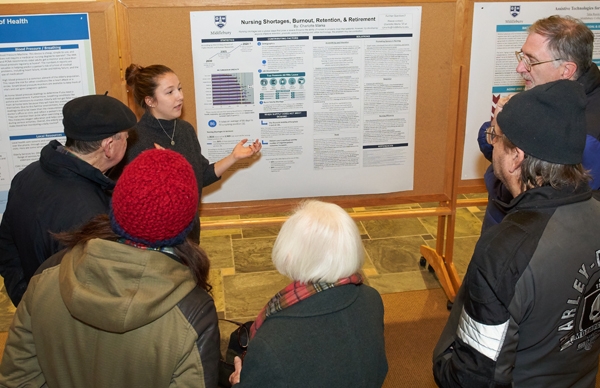
MIDDLEBURY, Vt. – “You can’t focus on health if you’re afraid of being evicted,” said Pam Berenbaum, director of Middlebury’s global health program and professor of the practice of global health.
The connections between health and living conditions—housing, transportation, clean water, social stress, income, and so on—are being recognized as “more and more important, as more people are slipping through the cracks.”
“Take readmissions after surgery,” Berenbaum continued. “People come in, they have the surgery. That’s great. Then they get sent home where there aren’t enough supports, they don’t have adequate nutrition, their house is really cold because they can’t pay their heating bills—and they’re backsliding. Maybe they don’t have access to transportation, or they’re an older person who doesn’t feel comfortable driving in the snow anymore, and no one’s checking on them. So then they come back through the emergency room sicker than they were before.”
While it’s still unusual for healthcare systems to consider such social determinants of health, Vermont is an early leader, she said.
With this in mind, Berenbaum focused the capstone project for her fall 2019 Global Health class on “community-connected research” to be shared with Porter Medical Center, the local hospital and healthcare system in Middlebury.
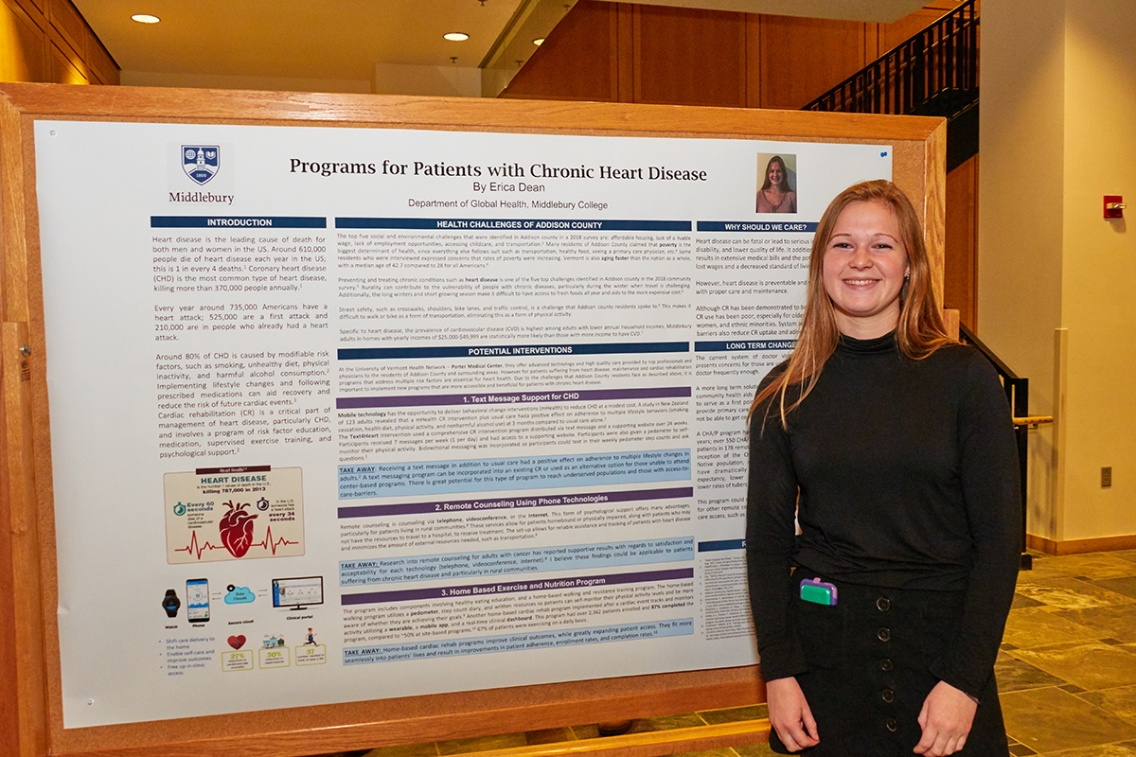
Erica Dean ’20 researched social determinants of health as related to patients with chronic heart disease.
The project was kick-started last summer when then PMC president Seleem Choudhury contacted Berenbaum about a report on social determinants of health in Addison County that she and Middlebury student Alessandria Schumacher ’17 coauthored in 2015.
“He said, ‘I read your report and I want to hear your thoughts on what Porter can do.’”
Using that 2015 report as the starting point, Berenbaum’s students looked at known obstacles to health in Addison County and looked for solutions that had been road tested in similar communities.
“Something tried in San Diego, maybe, is not really relatable, but something tried in rural Minnesota might be. Students basically scoured the literature for what else has been tried. What do we know about how well this works? What organizations were involved? Did the hospital partner with nonprofits or faith organizations? How was this carried out?”
The 29 students considered such issues as opioid dependence; alcohol abuse and driving while intoxicated; healthcare workers’ cultural competence in caring for local migrant workers; fitness and nutrition support for persons with chronic conditions like heart disease and type 2 diabetes.
The practical emphasis of the research, said Berenbaum, fits well with her approach to teaching.
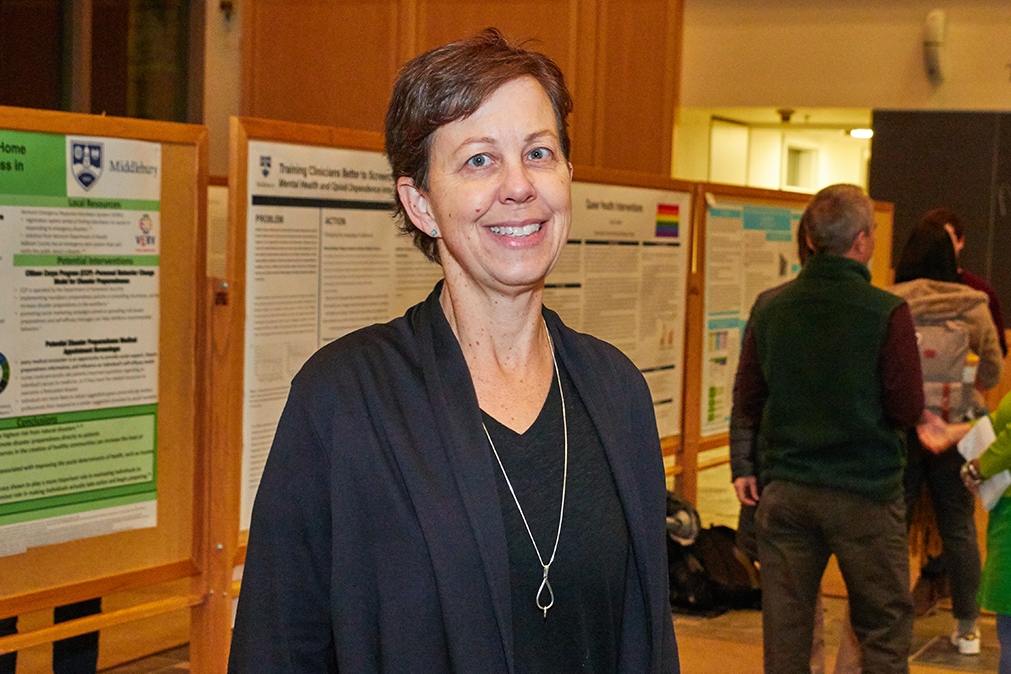
Professor of the Practice Pam Berenbaum taught a course in which students researched social determinants of health problems in the local community, and possible solutions.
“I spent a career in public health, so my approach isn’t theoretical—it’s about problem solving with an interdisciplinary team using as much information as you have at the time and you just have to move it forward. For public health professionals, this is reality.”
The students’ projects incorporated what Berenbaum describes as “public health ethics: appreciation for the complexity of policy problems; inclusion of data and evidence in decision making; consideration of a range of influences over health; the practice of compassion, rather than judgment, in understanding stigmatized behavior.”
Senior Alec Rogers researched the use of mobile health clinics (MHCs) to improve elder care in rural settings. Typically, in such programs, a modified RV or van staffed by health professionals travels to an underserved community. Rogers found that MHCs save $12 for every $1 spent and currently provide “6.5 million annual patient visits” nationwide. Particularly interesting was a university-run program in Idaho that combined health delivery and training in a variety of health disciplines, such as nursing, dietetics, and physical therapy.
Rogers’s major takeaway from the class?
“You don’t have to be sitting on the sidelines. You can jump in. You can do the research and start developing solutions, which is empowering. It’s cool to start thinking that way.”
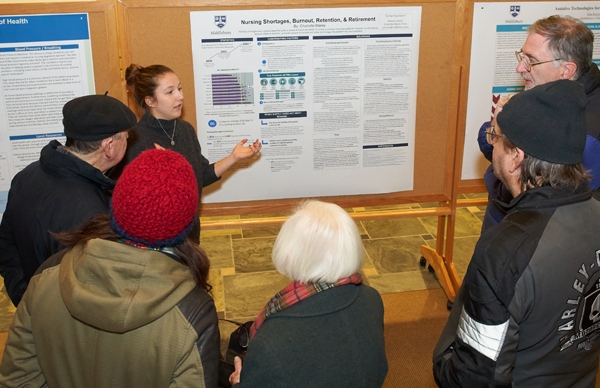
Charlotte Marks ’23 explains her research on nursing shortages in Vermont and the rest of the U.S.
First-year student Charlotte Marks said she was drawn to her research topic—nursing shortages, retention, and burnout—in part because of a 2018 ballot initiative in her home state of Massachusetts to limit nurse–patient ratios. Marks found that Vermont expects to have close to 4,000 job vacancies for nurses in 2020. The United States as a whole expects to see a shortage of 800,000 nurses in 2020. As she began her research, Marks was surprised to find plenty of descriptions of the problem but very little in the way of solutions. For that she had to broaden her research to health systems in other countries, including Belgium, the United Kingdom, and Australia.
Marks said she loved the challenge of knowing her research could be used by an important local organization.
“This is my first real experience with research that was going to be put somewhere and be important to someone else—not just my professor. It felt like a lot of pressure, but a good kind of pressure. It was exciting. It meant that everything needed to be presented in a manner that was concise but gave enough information that Porter professionals can use it to inform their own decision making. It’s amazing to me that I can be doing something like this as a first-year.”
Marks said the class also opened her eyes to public health as a possible medical career.
“There’s just so many different directions that the field can take you.”
Senior Francesca Napoli and junior Trishabelle Manzano both pursued research in areas where they have longstanding interests: for Napoli, maternal health; for Manzano, trauma-informed care. Both are premed, and both are global health minors.
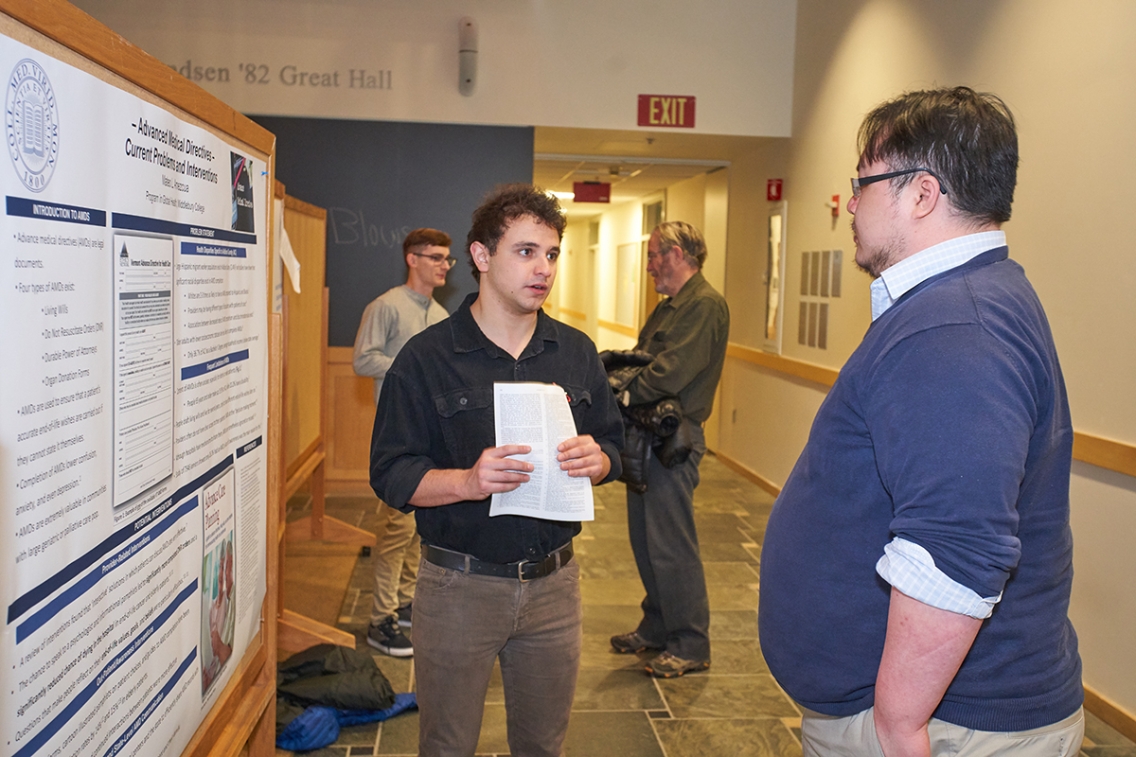
Mateo Amezcua ’20 describes his research on advanced medical directives during a poster session in Bicentennial Hall.
Napoli found that while having a baby is the most common reason for hospital admission nationwide, rural hospitals have been closing their obstetric units “at an alarming rate,” as a cost-cutting measure. Specific challenges in Vermont include providing maternal care for migrant workers and a fivefold increase in neonatal abstinence syndrome (NAS), corresponding to Vermont’s opioid epidemic. (NAS is when babies experience withdrawal because of the mother’s substance abuse.) Looking at effective responses to NAS, she highlighted the Rocking Horse Circle of Support program in Bennington, Vt., which provides free counseling and support to pregnant women looking to address alcohol and substance abuse.
Manzano researched the emerging field of trauma-informed care (understanding how childhood trauma can affect health at all ages).
“The main challenge is that this approach is relatively new in the medical field,” Manzano said, noting that trauma-informed care began to enter medical school curriculums only as recently as 2016. Practices can be as simple as being a good listener, spending more time with patients, or asking for consent before touching patients. She found that as little as six hours of training in trauma-informed care can result in better diagnoses.
Both Manzano and Napoli said that their research projects had given them a lot to reflect on as future MDs, in terms of how they would want to practice medicine.
“For me, the main thing was also the most simple,” said Manzano. “Not forgetting your humanity and your capacity for showing empathy and compassion. Doctors go through years and years of training, but it’s so important to just go back to basic relationships and connecting with people.”
Said Napoli: “I want to make sure that whoever comes to me, regardless of what they are struggling with in terms of their mental health or anything else, they feel included and they feel cared for.”
Research culminated in two public presentations and was then turned over to Chief Medical Officer Anna Benvenuto, a key player in Porter Medical Center’s population health initiatives and a 2000 Middlebury graduate in biology and environmental studies.
“I really appreciated the lens that the students had on this because as someone who is within the system and has been within the system for years now, it’s nearly impossible to fully step outside and offer new solutions,” said Benvenuto. “I appreciated their ability to look at it with a fresh set of eyes and say, ‘Here’s the things that are not going well. Here are the solutions that could be considered.’ And they think really big. Sometimes those of us in the midst of it think within our constraints. We know what the guardrails are, we know the budgetary limitations, the time limitations, the cultural limitations of something. This helps us think about things in a completely different way.”
Benvenuto said she’ll be sharing the student research with the rest of Porter’s population health team.
“What we’re doing next is thinking about our priorities as a health service area. This research can help us figure out the next steps and give us some ideas about where to start.”

